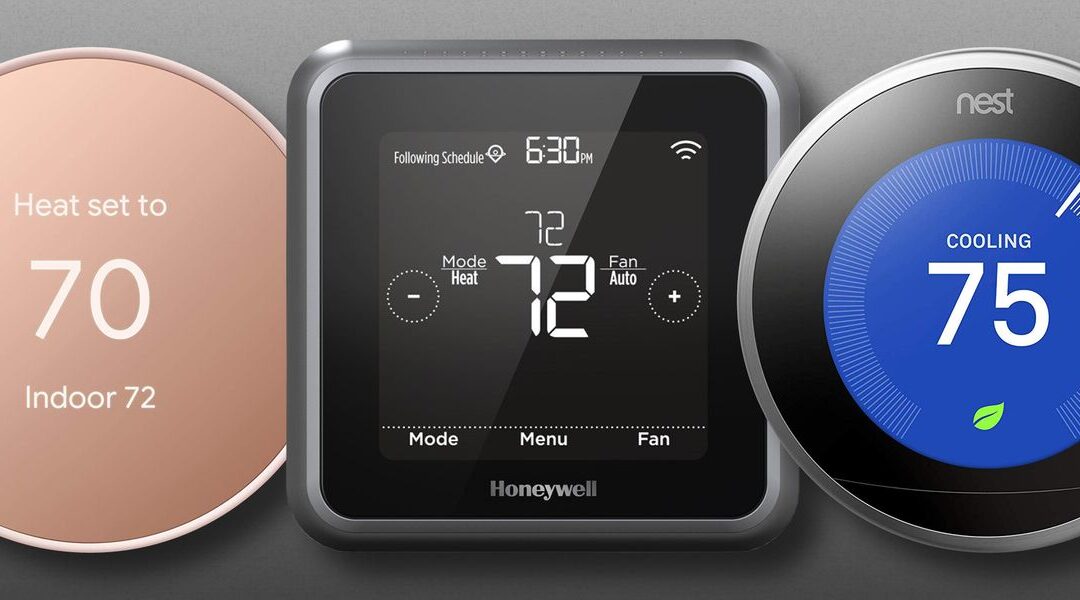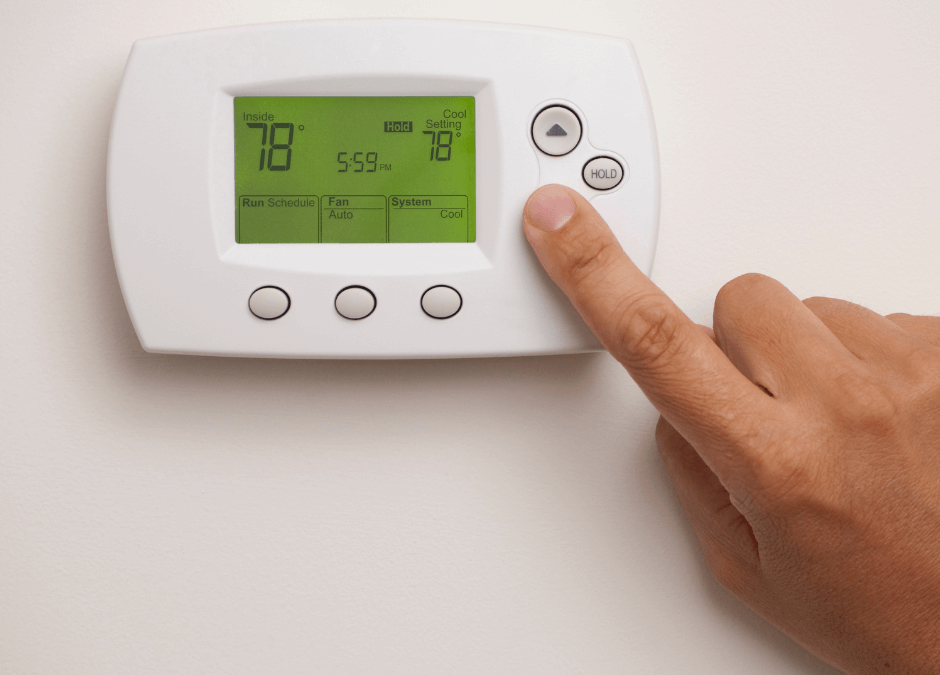Check Best Thermostat Pricing in Amazon
** As an Amazon Associate, I earn from qualifying purchases.
Your thermostat may change temperature on its own due to programmed settings or sensor issues. Another cause could be a software glitch.
Modern thermostats often come with advanced features like scheduling and smart programming. These functionalities allow them to automatically adjust temperatures based on pre-set schedules or detected occupancy. Sometimes, users might forget about these settings, leading to unexpected temperature changes. Sensor malfunctions can also cause erratic temperature adjustments.
Dust, dirt, or incorrect placement of the thermostat might affect its ability to read the room temperature accurately. Software glitches or outdated firmware can further contribute to this issue. Regular maintenance and firmware updates can help mitigate these problems, ensuring your thermostat functions correctly.
- The Heart Of Home Comfort
- Common Causes Of Temperature Fluctuation
- Technical Troubles
- Programmable Vs. Manual Thermostats
- Environmental Effects
- User Interactions
- Smart Thermostats: A Game Changer
- Solving The Temperature Puzzle
- The Future Of Thermostat Technology
- Frequently Asked Questions
- Conclusion
The Heart Of Home Comfort
The thermostat is the heart of home comfort. It keeps the indoor climate steady and comfortable. But sometimes, it changes the temperature on its own. This can be puzzling and frustrating. Understanding the reasons behind this can help in managing your home’s comfort better.
Thermostat Functionality
A thermostat is a small but crucial device. It measures the temperature of your home and adjusts it to match your settings. It connects to your heating and cooling systems. When it senses a temperature change, it sends signals to these systems to turn on or off.
Smart thermostats have advanced features. They learn your schedule and adjust the temperature accordingly. These thermostats can also connect to your smartphone. This allows you to control the temperature from anywhere.
Sometimes, the thermostat changes the temperature on its own. This could be due to the settings you have programmed. It could also be due to external factors like sunlight or drafts. Understanding how your thermostat works is key to solving these issues.
Significance In Climate Control
The thermostat plays a vital role in climate control. It ensures that your home stays at a comfortable temperature. A well-functioning thermostat can save energy and reduce your utility bills.
Energy efficiency is one of the main benefits of a good thermostat. By keeping the temperature stable, it prevents your heating and cooling systems from overworking. This not only saves energy but also extends the life of your HVAC systems.
Thermostats also improve indoor air quality. By maintaining a consistent temperature, they help in reducing humidity levels. This prevents the growth of mold and mildew, which can harm your health.
| Thermostat Type | Features |
|---|---|
| Manual | Basic temperature control, no programming |
| Programmable | Set schedules for different times and days |
| Smart | Learning capabilities, remote control, energy reports |
Understanding the type of thermostat you have can help in troubleshooting temperature changes. Each type has its own set of features and functionalities. Knowing these can make a big difference in maintaining home comfort.

Credit: dfwtopinspect.com
Common Causes Of Temperature Fluctuation
One of the most frustrating issues for homeowners is when their thermostat changes temperature on its own. Understanding the common causes of temperature fluctuation can help you maintain a comfortable home environment and avoid unnecessary energy costs.
Location And Installation Factors
The placement of your thermostat plays a crucial role in its performance. If it’s installed near a heat source like a stove or a sunny window, it can cause inaccurate temperature readings.
For optimal performance, ensure the thermostat is installed on an interior wall, away from direct sunlight, drafts, or heat-producing appliances.
Incorrect installation can also lead to temperature swings. Make sure the thermostat is level and firmly attached to the wall.
Dirt And Dust Impact
Over time, dirt and dust can accumulate inside the thermostat. This buildup can interfere with its sensors and internal components, leading to erratic temperature changes.
Regular cleaning can help maintain its accuracy. Use a soft brush or a can of compressed air to remove any debris.
Neglecting to clean your thermostat can result in poor performance and higher energy bills. A clean thermostat ensures precise temperature control and a comfortable living space.
Technical Troubles
Is your thermostat changing temperature on its own? This can be frustrating. Understanding the technical troubles can help you solve this issue. Let’s explore some common technical problems.
Wiring Issues
Faulty wiring can cause your thermostat to behave erratically. Wires might be loose or improperly connected. This can lead to temperature changes without warning.
Checking the wiring is crucial. Make sure all connections are secure. Use a multimeter to verify the integrity of the wires.
| Wiring Issue | Possible Solution |
|---|---|
| Loose Connections | Tighten all screws and connectors |
| Damaged Wires | Replace damaged sections with new wiring |
| Improper Installation | Reinstall wiring according to manufacturer guidelines |
Sensor Malfunctions
Thermostat sensors play a key role in temperature regulation. If the sensor is faulty, the thermostat can’t read the temperature accurately. This can cause unexpected changes.
Check the sensor for dust and debris. Clean it with a soft cloth. If cleaning doesn’t help, consider replacing the sensor. Follow the instructions in the manual for proper sensor installation.
- Clean the sensor regularly to maintain accuracy.
- If cleaning doesn’t work, replace the sensor.
- Follow the manufacturer’s manual for sensor replacement.
Programmable Vs. Manual Thermostats
Choosing between a programmable thermostat and a manual thermostat can impact how your home’s temperature is controlled. Each type offers distinct features and benefits that cater to different needs. Understanding these differences can help you decide which thermostat is right for you.
Setting Conflicts
A manual thermostat requires you to set the temperature manually. This can lead to setting conflicts if multiple people in the household adjust the thermostat. These conflicts can cause inconsistent temperature settings, leading to discomfort.
On the other hand, a programmable thermostat allows you to set a schedule for temperature changes. This can prevent conflicts, as the thermostat will follow a preset program. This ensures a consistent and comfortable temperature throughout the day.
Advantages Of Programmable Models
Programmable thermostats offer several advantages:
- Energy Efficiency: They can reduce energy consumption by adjusting the temperature when you are not home.
- Convenience: You can set it once and forget it. The thermostat will handle the rest.
- Customization: Different programs can be set for weekdays and weekends.
The table below highlights the key differences between programmable and manual thermostats:
| Feature | Manual Thermostat | Programmable Thermostat |
|---|---|---|
| Temperature Control | Manual adjustment | Automatic scheduling |
| Energy Efficiency | Less efficient | More efficient |
| Convenience | Requires frequent adjustments | Set it and forget it |
| Customization | Limited | High |
Choosing the right thermostat can make a significant difference in your home’s comfort and energy usage. Understanding the key differences can help you make an informed decision.
Environmental Effects
Environmental factors significantly affect thermostat behavior. Many people experience their thermostats changing temperature on their own. This phenomenon can be attributed to various environmental influences. Understanding these effects can help you maintain a stable and comfortable home environment.
Impact Of External Temperature
External temperature changes can cause your thermostat to adjust settings. For example, a sudden drop in outside temperature might prompt your system to heat up more. Conversely, a rise in temperature can lead the system to cool down.
Thermostats often have sensors that detect outdoor temperature fluctuations. These sensors help the thermostat maintain a comfortable indoor climate. However, extreme or rapid changes can still cause noticeable shifts in your home’s temperature.
Sunlight And Heat Sources
Direct sunlight can significantly affect your thermostat’s readings. When sunlight hits the thermostat, it can cause the device to think the room is warmer than it actually is. As a result, the system may cool the room unnecessarily.
Other heat sources, like ovens and fireplaces, can also impact thermostat readings. These heat sources can trick the thermostat into adjusting the temperature. Positioning the thermostat away from these sources can help maintain more accurate readings.
| Environmental Factor | Effect on Thermostat |
|---|---|
| External Temperature | Causes thermostat to heat or cool based on outside temperature changes. |
| Sunlight | Direct sunlight can cause the thermostat to read a higher temperature. |
| Heat Sources | Ovens and fireplaces can make the thermostat think the room is hotter. |
Addressing these environmental effects can help you maintain a consistent indoor temperature. Ensuring your thermostat is placed in an optimal location is crucial.
User Interactions
Many homeowners wonder why their thermostats change temperature on their own. The answer often lies in user interactions. These unintentional or intentional changes can cause confusion. Understanding these interactions can help you maintain a consistent home temperature.
Check Best Thermostat Pricing in Amazon
** As an Amazon Associate, I earn from qualifying purchases.
Accidental Adjustments
Accidental adjustments are common. Sometimes, you may accidentally touch the thermostat. This can change the settings without you realizing it.
Children might also play with the thermostat. They might press buttons out of curiosity. This can lead to unexpected temperature changes.
Pets can also cause accidental adjustments. If your thermostat is within their reach, they might bump into it. This can alter the temperature settings.
Multiple Users, Multiple Preferences
Having multiple users in a household can complicate thermostat settings. Each person may have different temperature preferences.
For example, one person might prefer a cooler environment. Another person might like it warmer. These differing preferences can lead to frequent changes in the thermostat settings.
To illustrate, here’s a simple table that shows potential user preferences:
| User | Preferred Temperature |
|---|---|
| Person A | 68°F |
| Person B | 72°F |
These varying preferences can cause the thermostat to fluctuate. This can make it seem like the thermostat is changing on its own.
To manage this, consider setting a compromise temperature. This can help keep everyone comfortable and reduce frequent adjustments.
Smart Thermostats: A Game Changer
Smart thermostats are transforming how we control home temperatures. They are intelligent, efficient, and user-friendly. These gadgets offer more than just basic temperature control. They learn your habits and can be adjusted remotely.
Learning Your Habits
Smart thermostats can learn your daily routines. They remember when you wake up, leave for work, and return home. This helps them adjust temperatures automatically. No more manual changes!
For example, if you wake up at 7 AM, the thermostat will start warming the house before that. It ensures you wake up to a cozy home. Similarly, it lowers the temperature when you are away. This saves energy and reduces bills.
Here is a simple table to show how it works:
| Time | Temperature |
|---|---|
| 6:30 AM | 70°F (21°C) |
| 8:00 AM | 65°F (18°C) |
| 6:00 PM | 72°F (22°C) |
Remote Adjustments And Smart Devices
Smart thermostats connect with your phone or tablet. You can adjust the temperature remotely. This is handy if you forget to change settings before leaving home.
You can also link your thermostat to other smart devices. For instance, connect it with Alexa or Google Home. This allows you to control it with voice commands. Say, “Alexa, set the thermostat to 68°F,” and it will obey.
Here are some benefits of remote adjustments and smart devices:
- Convenience: Adjust settings without getting up.
- Energy Efficiency: Save energy by optimizing temperatures.
- Integration: Seamless connection with other smart home devices.

Credit: wyckoffcomfort.com
Solving The Temperature Puzzle
Have you ever wondered why your thermostat changes temperature on its own? This mysterious behavior can be confusing. The good news is, you can solve this temperature puzzle. Understanding the reasons behind this issue will help you fix it.
Let’s explore some practical steps to resolve this problem. We’ll look at maintenance tips and know when to call a professional.
Maintenance Tips
Regular maintenance keeps your thermostat running smoothly. Below are some simple tips:
- Check the batteries: Weak batteries can cause your thermostat to act up. Replace them regularly.
- Clean the thermostat: Dust and dirt can interfere with its sensors. Use a soft brush or cloth to clean it.
- Inspect the wiring: Loose or damaged wires can lead to erratic temperature changes. Ensure all connections are tight.
- Update the software: Some thermostats need software updates to function correctly. Check the manufacturer’s website for updates.
When To Call A Professional
Sometimes, a professional’s help is necessary. Here are some scenarios:
- Frequent temperature changes: If your thermostat frequently changes temperature, it may need expert attention.
- Unresponsive thermostat: If it doesn’t respond to your settings, a technician can diagnose the problem.
- Electrical issues: If you suspect electrical problems, it’s best to call a professional to avoid risks.
- Complex systems: Smart thermostats and advanced HVAC systems may require specialized knowledge.
By following these tips and knowing when to seek professional help, you can keep your thermostat functioning correctly.
The Future Of Thermostat Technology
The future of thermostat technology is rapidly evolving. Homeowners are witnessing smarter and more intuitive systems. These systems not only enhance comfort but also save energy and cut costs. Let’s explore the innovations transforming the way we control home climates.
Innovations On The Horizon
Thermostats are becoming more advanced with each passing year. Smart thermostats now use artificial intelligence to learn your preferences. They adjust temperatures based on your daily habits. This means your home stays comfortable without manual adjustments.
Voice control is another exciting development. Imagine telling your thermostat to change the temperature while you relax on the couch. This integration with smart home systems simplifies climate control.
Geo-fencing technology uses your smartphone’s location to adjust the thermostat. It lowers the temperature when you leave home and raises it when you return. This ensures energy efficiency and comfort.
Towards Smarter Climate Control
Machine learning algorithms are making thermostats smarter. They analyze data to predict the best temperature settings. This predictive capability means the system gets smarter over time.
Remote access is another key feature. You can control your thermostat from anywhere using a smartphone app. This is perfect for those who travel often or have irregular schedules.
Energy reports are provided by modern thermostats. These reports show your energy usage patterns. They offer tips to reduce consumption and save on bills.
| Feature | Description |
|---|---|
| AI Learning | Adjusts based on your daily habits |
| Voice Control | Change settings with voice commands |
| Geo-fencing | Uses location data to adjust temperature |
| Remote Access | Control via smartphone app |
| Energy Reports | Provides insights on energy usage |
These innovations are just the beginning. The future of thermostat technology promises even greater advancements. Stay tuned for more exciting updates in this field.

Credit: zerohvacandrefrigeration.com
Frequently Asked Questions
How Do I Stop My Thermostat From Changing Temperature?
To stop your thermostat from changing temperature, set it to “hold” mode. This maintains a constant temperature. Check your thermostat’s manual for specific instructions.
How Do You Know When Your Thermostat Is Going Bad?
A bad thermostat often shows incorrect temperature readings, short cycles, or causes inconsistent heating or cooling. Energy bills may rise.
Why Is My Thermostat Not Staying At The Temperature I Set?
Your thermostat may not stay at the set temperature due to faulty sensors, incorrect settings, or a malfunctioning unit.
Why Is My Home Thermostat Fluctuating?
Your home thermostat may fluctuate due to faulty wiring, dirty sensors, low batteries, or incorrect placement. Check these factors.
Conclusion
Understanding why your thermostat changes temperature on its own is essential. It could be due to faulty sensors, outdated software, or incorrect settings. Regular maintenance and timely updates can help. If problems persist, consult a professional. Ensuring your thermostat functions correctly enhances comfort and energy efficiency in your home.
Check Best Thermostat Pricing in Amazon
** As an Amazon Associate, I earn from qualifying purchases.


